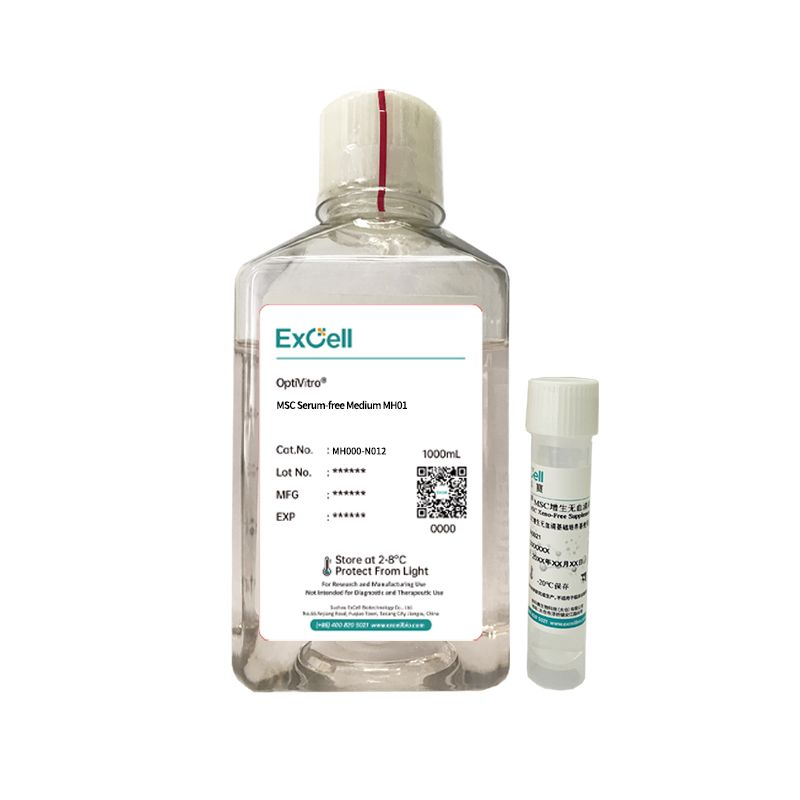Mesenchymal Stem Cells (MSCs) are one of the most promising tools in regenerative medicine and cell therapy, primarily due to their remarkable multipotency—the ability to differentiate into multiple cell lineages, including bone, fat, and cartilage. However, harnessing this potential requires more than just standard basal culture; it demands precise control over the cellular microenvironment.
The success of any differentiation protocol hinges entirely on the quality and composition of the culture medium. This guide explores the foundational principles of engineering specialized media to direct MSC fate with accuracy, relying on chemically defined, high-quality starting platforms, like those offered by ExCell Bio.
The Critical Foundation: Why Defined Basal Media Matters
Before attempting to induce differentiation, researchers must ensure their cell stock is robust, healthy, and capable of multipotency. This is the stage where the CHOice of basal medium—the MSC media used for expansion—is paramount.
Historically, MSCs were cultured in Fetal Bovine Serum (FBS)-supplemented media. However, the inherent variability, undefined components, and regulatory risks associated with animal serum make it unsuitable for clinical applications and inconsistent for research. The modern requirement, especially for CGT (Cell and Gene Therapy) applications, is a xeno-free, serum-free, and chemically defined platform.
ExCell Bio’s MSC Serum-Free Medium (MSC-SFM) products, such as MH01 and MH02, are engineered precisely for this purpose. They provide a stable, defined foundation that simplifies the subsequent, complex differentiation steps.
A defined, GMP-grade basal medium ensures:
- Reduced Variability: Eliminates lot-to-lot inconsistencies associated with FBS.
- Safety and Compliance: Meets the stringent safety and regulatory requirements for clinical use (GMP-grade, Xeno-free).
- Maximized Proliferation: Supports efficient expansion while maintaining key MSC characteristics (adherence and trilineage potential).
Starting with a high-performance medium allows researchers to isolate and expand MSCs efficiently (yielding high harvest and expansion folds up to 6-10 times in 72 hours, as demonstrated by the MH01/MH02 products) without compromising the cell’s fundamental ability to later differentiate.
The Trilineage Toolkit: Core Components for Specific Differentiation
The formulation for differentiation media involves supplementing a robust basal medium with a targeted cocktail of hormones, vitamins, and growth factors. These exogenous factors act as molecular switches, triggering specific transcription factors (TFs) that determine the cell’s final fate.
1. Osteogenic Differentiation (Bone)
Osteogenesis is the process of MSC commitment toward osteoblasts, leading to mineralized matrix deposition. The media formulation must drive the activation of the Runx2 and Osterix transcription factors.
| Component | Function | Biological Role |
| Dexamethasone | Synthetic Glucocorticoid Hormone | Key signaling molecule; drives commitment and stimulates ALP activity. |
| Ascorbic Acid-2-Phosphate | Vitamin C Derivative | Essential cofactor for collagen synthesis (Type I, the primary component of bone matrix). |
| $\beta$-Glycerophosphate | Phosphate Source | Provides the inorganic phosphate necessary for matrix mineralization (calcium deposition). |
Protocol Note: Osteogenic differentiation typically requires maintaining the cells at or above 100% confluency to initiate cell-cell signaling crucial for matrix formation, usually over a period of 14 to 21 days.
2. Adipogenic Differentiation (Fat)
Adipogenesis drives MSCs toward lipid-storing adipocytes, regulated primarily by the Peroxisome Proliferator-Activated Receptor gamma ($\text{PPAR}\gamma$) transcription factor.
| Component | Function | Biological Role |
| Dexamethasone | Synthetic Glucocorticoid Hormone | Initial signaling cue; often used to drive both osteo/adipo commitment. |
| 3-Isobutyl-1-methylxanthine (IBMX) | Phosphodiesterase Inhibitor | cAMP pathway activator; increases intracellular cAMP, promoting adipogenic signaling. |
| Insulin or Hydrocortisone | Hormonal Supplement | Necessary for glucose uptake, lipid synthesis, and promoting cell survival during differentiation. |
Protocol Note: Adipogenesis is generally initiated at high confluency (80-90\%) and is confirmed by the formation of intracellular lipid vacuoles, often stained with Oil Red O.
3. Chondrogenic Differentiation (Cartilage)
Chondrogenesis commits MSCs toward CHOndrocytes, which produce a specialized extracellular matrix (ECM) rich in Type II collagen and proteoglycans like Aggrecan. This pathway has unique media and culture requirements.
| Component | Function | Biological Role |
| Transforming Growth Factor-Beta (TGF-beta) | Growth Factor (TGF-beta1 or beta3 | The primary morphogen; essential for cartilage induction and activating the Sox9 transcription factor. |
| Ascorbic Acid | Cofactor | Supports the synthesis and cross-linking of the resulting collagen matrix. |
| Dexamethasone | Signaling Cue | Required for initial pathway commitment. |
Protocol Note: Chondrogenic differentiation is highly reliant on 3D culture conditions (e.g., pellet or scaffold culture) to mimic the natural cartilage environment. This physical constraint is as critical as the media formulation itself.
High-Quality Basal MSC media for Predictable Results from ExCell Bio
Achieving consistent, reproducible differentiation across multiple passages demands that the basal MSC media be impeccably formulated and manufactured. This is particularly true in clinical settings where regulatory scrutiny is highest.
ExCell Bio’s MSC-SFM products meet this need by providing:
- Xeno-Free Reliability: The MH01 is a fully Xeno-free, chemically defined medium, offering the highest tier of safety and consistency for downstream clinical processes.
- Differentiation Potential Retention: Comprehensive quality control testing confirms that MSCs expanded in ExCell Bio media retain their tri-lineage differentiation capability. The cells maintain the required ISCT (International Society for Cell & Gene Therapy) phenotype, including high positivity rates for CD73, CD90, and CD105 (typically >99%) and negativity for hematopoietic markers.
- Convenience: The readiness-to-use formulation eliminates the need for plate coating, saving precious researcher time and reducing protocol complexity.
By standardizing your expansion phase with a GMP-grade product, you minimize the “noise” introduced by variable reagents, allowing the precise, supplemental differentiation factors to exert their full, intended effects. This precision is non-negotiable for anyone pursuing high-fidelity MSC research or developing clinical-grade therapies. The integrity of your base MSC media defines the ceiling of your differentiation outcomes.


